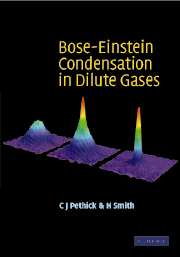Book contents
- Frontmatter
- Contents
- Preface
- 1 Introduction
- 2 The non-interacting Bose gas
- 3 Atomic properties
- 4 Trapping and cooling of atoms
- 5 Interactions between atoms
- 6 Theory of the condensed state
- 7 Dynamics of the condensate
- 8 Microscopic theory of the Bose gas
- 9 Rotating condensates
- 10 Superfluidity
- 11 Trapped clouds at non-zero temperature
- 12 Mixtures and spinor condensates
- 13 Interference and correlations
- 14 Fermions
- Appendix. Fundamental constants and conversion factors
- Index
10 - Superfluidity
Published online by Cambridge University Press: 06 July 2010
- Frontmatter
- Contents
- Preface
- 1 Introduction
- 2 The non-interacting Bose gas
- 3 Atomic properties
- 4 Trapping and cooling of atoms
- 5 Interactions between atoms
- 6 Theory of the condensed state
- 7 Dynamics of the condensate
- 8 Microscopic theory of the Bose gas
- 9 Rotating condensates
- 10 Superfluidity
- 11 Trapped clouds at non-zero temperature
- 12 Mixtures and spinor condensates
- 13 Interference and correlations
- 14 Fermions
- Appendix. Fundamental constants and conversion factors
- Index
Summary
The phenomena of superfluidity and superconductivity are intimately connected with the existence of a condensate, a macroscopically occupied quantum state. Such condensates occur in a variety of different physical systems, as described in Chapter 1. The foundation for the description of superfluidity is a picture of the system as being comprised of a condensate and elementary excitations. In Chapter 8 we have seen how physical properties such as the energy and the density of a Bose–Einstein condensed system may be expressed in terms of a contribution from the condensate, plus one from the elementary excitations, and in this chapter we shall consider further developments of this basic idea to other situations. As a first application, we determine the critical velocity for creation of an excitation in a homogeneous system (Sec. 10.1). Following that, we show how to express the momentum density in terms of the velocity of the condensate and the distribution function for excitations. This provides the basis for a two-component description, the two components being the condensate and the thermal excitations (Sec. 10.2). In the past, this framework has proved to be very effective in describing the properties of superfluids and superconductors, and in Sec. 10.3 we apply it to dynamical processes.
To describe the state of a superfluid, one must specify the condensate velocity, in addition to the variables needed to characterize the state of an ordinary fluid. As a consequence, the collective behaviour of a superfluid is richer than that of an ordinary one. Collective modes are most simply examined when excitations collide frequently enough that they are in local thermodynamic equilibrium.
- Type
- Chapter
- Information
- Bose–Einstein Condensation in Dilute Gases , pp. 264 - 288Publisher: Cambridge University PressPrint publication year: 2001



